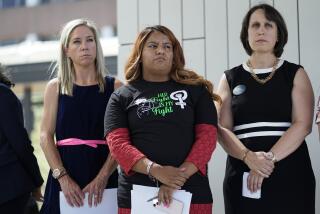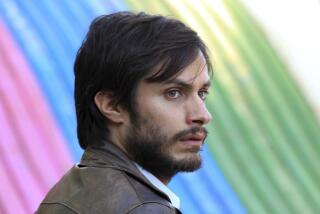Sundance 2016: A film festival tackles gun violence, from many angles
- Share via
There were more than 40 mass shootings in the United States last year, prompting many politicians to hold forth and a large number of Americans to simply shake their heads. What needed to happen, they asked, for these tragedies to stop?
Now a new group is entering the debate: independent filmmakers.
When the Sundance Film Festival begins Thursday, it will do so with a rare accumulation of movies about the subject of gun safety. All of them hope to raise questions, if not provide solutions, in a place that has long been a ground zero for cultural movements.
SIGN UP for the free Indie Focus movies newsletter >>
“Every conversation has to start somewhere, and sometimes that somewhere is Park City,” Utah, said AJ Schnack, a documentary-film veteran who, with the input of Oscar winner Laura Poitras, has directed “Speaking Is Difficult,” a short about gun violence that will premiere at the festival. “Clearly everyone’s been talking about the issue, but the hope is that by talking about it artistically we can have a different kind of conversation.”
Schnack’s movie, a powerfully arranged collection of both everyday footage and 911 calls, is one of several films across both documentary and narrative categories to tackle mass shootings, defined by federal statute as the murder by gunfire of at least three people.
Others include Kim Snyder’s community portrait “Newtown,” the Katie Couric-produced policy piece “Under the Gun” and even a scripted film, Tim Sutton’s “The Dark Night.” An impressionistic tale set during the prelude to a movie-theater shooting, “Night” is loosely based on the tragedy at a multiplex in Aurora, Colo., in 2012 during a screening of “The Dark Knight Rises” that claimed the lives of 12 people.
Historically, Sundance, the nation’s most prestigious film festival, has displayed a flair for setting a cultural agenda. A decade ago, Davis Guggenheim’s “An Inconvenient Truth” helped kickstart a climate-change movement, and Gabriela Cowperthwaite’s “Blackfish” in 2013 was the beginning of a long campaign to influence a policy shift at Sea World.
But rarely do multiple movies on a single issue come along at the same time, and from so many different angles.
While “Under the Gun,” directed by past Couric collaborator Stephanie Soechtig, examines many of the policy aspects more directly, Snyder’s piece, about the December 2012 shootings at Sandy Hook Elementary School, is concerned primarily with the aftermath of gun violence in one community.
Legislative questions are not addressed, and even the killer’s name is not mentioned. Instead, viewers are given wrenching access to a place that more than three years later continues to grapple with an attack that claimed the lives of 26 victims, many of them small children.
“I have this need to know what he experienced,” Mark Barden, who lost a son in the attack, says in heartbreaking tones. Imagine, he continues “try[ing] to interpret what your 7-year-old experienced as he’s being murdered in his first-grade classroom.”
Or David Wheeler, another parent who lost a child at Sandy Hook, says of what he and his wife Francine have endured since their son Ben was killed. “We’re all terrified of forgetting what he looked like or sounded like.”
Snyder, a New York-based filmmaker, traveled to Newtown just weeks after the attack and slowly won the trust of an understandably guarded community. She said she hoped to show both the tragic effects of violence and the resilience that can emerge in its wake.
“This film is not an either/or policy piece,” she said of her movie, which is one of the most emotionally devastating movies this Sundance veteran has seen in some time. “I was trying to create a portrait of a collective trauma, and do it in a way that becomes universal. I think it speaks more to the issue of how a society deals with grief.”
An even more observational style characterizes the work of Sutton, a veteran narrative filmmaker who here offers an homage to Gus van Sant’s 2003 Cannes prize winner “Elephant” in exploring the topic.
Taking a restrained, meditative approach, he follows a series of largely young people in a suburban town on the day a movie-theater attack will soon take place. Sutton subverts expectations of who the shooter is while also reveling in the kind of banalities that heighten the effect of the impending brutality. “This [movie] is going to be amazing,” said one young moviegoer later in the film as she sat down in the theater, just after she compliments her friend on her eyeliner.
Though he describes himself as politically to the left and in favor of more gun restrictions, Sutton’s film contains no overt ideology, and he said he had little desire to offer a policy rebuke. He hoped instead to offer exposure to the people who are affected by gun violence and, especially via long takes of a character cleaning and maintaining his gun, the weapons themselves.
“I wanted to show guns and the space they occupy in suburban America,” Sutton, who grew up with modest exposure to guns in upstate New York, said. “They’re always around, and yet for a lot of people the only time they see them is in a Michael Bay movie. I wanted to get the audience really close to them, but not in a sensational or glitzy way.”
He added, “I didn’t want to explain or judge [gun usage]; i just wanted to observe. It’s just a portrait of America right now.”
But while almost everyone behind these pieces says they want to stay away from policy prescriptions on gun ownership, they are all motivated by a growing political dissatisfaction. The last five months of 2015 alone, they noted, saw brutal tragedies in locations as varied as Roseburg, Ore., Houston and San Bernadino.
“I think it’s the zeitgeist,” said Maria Cuomo Cole, who produced “Newtown.” “It’s burgeoning and burgeoning, and we are horrified and move on, then are horrified and move on again. As Americans we’re not very good at paying attention long-term; we’re mobilized and then fall back into our patterns.”
These films, she says, can create a more enduring reminder of the issue’s potency. (They also, it should be said, aim to offer an indie-film corrective of sorts to mainstream Hollywood, which on movie screens continues to glamorize gun violence.)
Gun safety has occasionally flickered across the Sundance radar. In 2014, for instance, William H. Macy’s narrative piece “Rudderless,” about a campus shooting, closed the festival. But these new movies seethe in a different way, complementing and compounding one another. Taken together, they yield a composite portrait of a creative class angered by inaction.
Schnack’s movie, which will debut in the coming months as part of a new season of the Field of Vision documentary series, stacks 911 calls from mass shootings—people in hushed scared tones speaking from hiding spots during the attacks to officious operators-- with a depressing repetiveness The idea that each time seems new and urgent to those victims is contrasted with the viewer’s growing sense of how familiar these calls have become.
Only when the film culminates in a speech from shooting victim and former U.S. Rep. Gabrielle Giffords (D.-Ariz.) is there some emotional release, and hope for a policy solution.
But whether these works of cinema can sway opinion is an open question. Even the most optimistic filmmakers say they know there are limits to how much they can move the needle on an issue on which many voters have long made up their minds. (That point was underscored recently when Taya Kyle, widow of “American Sniper” protagonist Chris Kyle, wrote a strongly worded op-ed for CNN arguing against gun safety laws.) The entrenched opinions on the issue, the filmmakers acknowledge, are infinitely more complex than the politics of responsibility articulated by movies like “Blackfish.”
Sundance filmmakers must also contend with the idea that they are simply speaking to the converted, particularly in a left-leaning industry like the independent-film business. As influential as the festival is among tastemakers and media elite, only a few movies each year, at most, break out in the larger culture and carry the possibility of reshaping a debate.
Festival organizers say they had no agenda in programming these movies. They simply slotted in the films because they saw a wave of powerful stories.
“I thought I knew a lot about Newtown before I saw this movie,” said festival director John Cooper. “And then I saw it and it changed my perception. You can be callous in looking at news stories in a way you don’t when you’re watching a film,” he added. “That’s why I think these movies can really help change the way you think.”
Either way, the festival and independent film world at large is unlikely to see the number of such movies slow down. Like Middle East war documentaries and other sprawling areas, the 2016 crop of gun movies may be less a moment than the beginning of a wave.
“As long as the problem doesn’t go away,” said Sutton, “neither will the films.”
You Might Also Like:
For ‘Citizenfour’ director Laura Poitras, a bold new platform
More to Read
Only good movies
Get the Indie Focus newsletter, Mark Olsen's weekly guide to the world of cinema.
You may occasionally receive promotional content from the Los Angeles Times.











